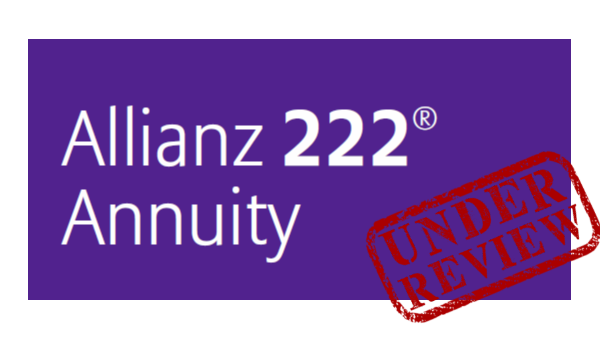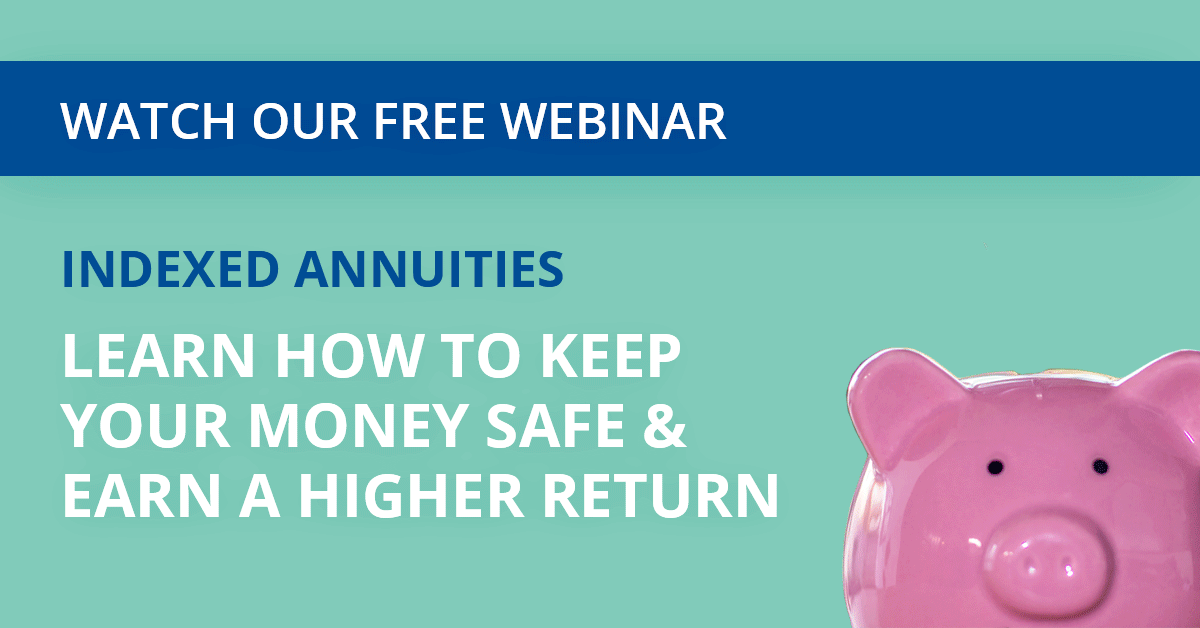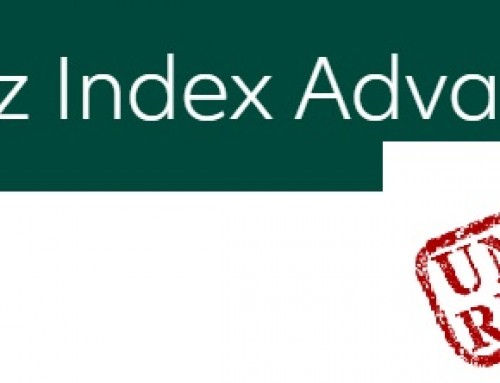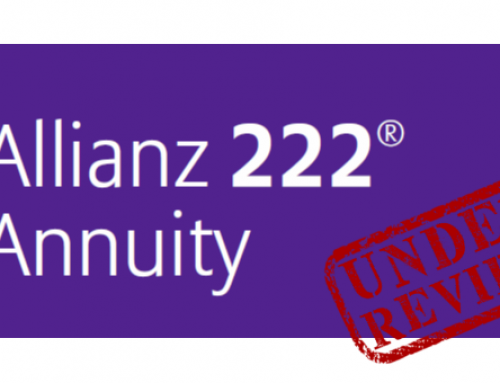Editor's Note: This post was originally published in May 2014 and has been updated for freshness, accuracy, and comprehensiveness.
The annuity business has grown in popularity as investors, especially those nearing retirement, look for options to protect themselves from stock market volatility and give them a decent income stream in retirement. With over $200 billion in annual sales, the annuity industry is big business with lots of salesmen trying to persuade you to make a purchase.
Today I will dig deep into the Allianz 222 Annuity which was launched in January of 2013 and was one of the best-selling indexed annuities in the industry for the 4th quarter of 2013. Sales of indexed annuities, a fixed annuity that provides a minimum guaranteed rate of interest combined with an interest rate tied to the movement of an index, increased to $39.3 billion in 2013, a 17% gain year over year. This is the biggest percentage increase of any form of annuity.
You will often hear that annuities are sold, not bought. This is exactly why I will go in depth into some of the most popular annuities because there is shockingly little information available about them. Most of the information comes from the companies that sell the annuities and they gloss over the fees, risks and downsides. More importantly, annuities have grown into extremely complex instruments which even the most seasoned professional may have trouble deciphering. Indexed annuities, often the black sheep of retirement products, have a history of being so complex that they were a focal point of litigation and regulatory action in the 2000s. While the negative attention led to a change for the better among the carriers, indexed annuities are still complex and difficult to truly understand.
It is of the utmost importance to make an informed decision. I have dealt with too many clients that have come to me asking for help getting out of an annuity and I can’t help after the fact. Stiff surrender penalties can’t be avoided for many years after you sign on the dotted line.
Perspective That You Can Trust
I am writing this blog from the perspective as a curious analyst. I am totally impartial as I am a fee-only registered investment advisor.I hope to bring a unique perspective to this topic drawing on my years of experience analyzing companies as a research analyst. I’ve met with hundreds of company CEOs and CFOs, including Steve Jobs and Richard Branson, and I will use my analytical skills to break down these complex instruments into something easier to understand.
While many investment professionals hate annuities, I do not believe that they are all bad and some of them can make sense as a small part of your investment portfolio. Annuities should never, I repeat never, be the large majority of your portfolio because of their lack of liquidity which is one of their biggest drawbacks.
Issuer Review: Allianz SE and Allianz Life
It is important to look at the issuer of the annuity first because annuities are NOT a guaranteed investment of any sort. This is important to note so I will say it one more time. Annuities are NOT guaranteed. They are only backed by the ability of the issuing insurance company’s ability to pay. Therefore if the issuer goes bankrupt, you are at risk of losing everything!
Allianz SE is a global financial services group headquartered in Munich, Germany.
It is the 5th largest money manager in the world. Allianz in North America includes PIMCO and Allianz Global Investors.
Allianz Life receives solid ratings from all the leading rating agencies.
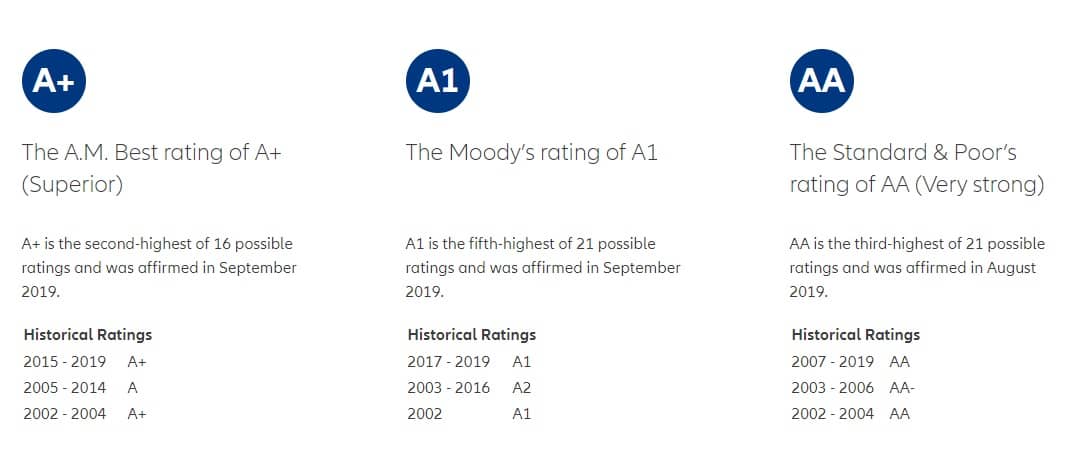
Allianz is the #1 seller of fixed annuities in the US. After a challenging year in 2012 when fixed annuities suffered a double-digit decline, Allianz had a very strong 2012 with sales of fixed index annuities rising 11%. Sheryl Moore, CEO of annuity research firm Wink said she thinks Allianz's relatively new “Allianz Preferred” program has boosted sales. She says, “The secret sauce is in that commission structure.” On the Allianz 222 Annuity, agents can earn 7.5% commission in year one in addition to commissions in following years.
Annuity Review: Allianz 222 Annuity
Maximum age for initial purchase: 80
Minimum initial premium: $20,000; additional premium accepted through first 3 contract years
Website: www.allianzlife.com
Beware of Surrender Fees
Surrender charges and period for this annuity are typical of most indexed annuities. Surrender fees go for 10 years and are 10% for the first 3 years!
After the 1st contract year, you may withdraw 10% each year without surrender fees. However, if you are under age 59.5, you are subject to a 10% IRS tax penalty as well as income taxes.

I believe surrender fees are one of the worst features of annuities. These are huge lockup fees and if you need the money, they sock it to you. This is why annuities should NEVER be a significant part of your investment portfolio because they are essentially illiquid for many years. Unless you are positive you will not need access to these funds, then annuities are NOT for you.
The Allianz pitch as per their brochure
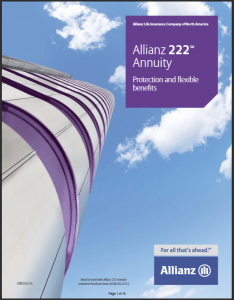
Allianz highlights these points:
- Provides level payments for the rest of your life
- Provides lifetime income plus an opportunity for payment increases
- Allianz Income Multiplier (AIM) benefit, allows you to double annual maximum income withdrawal if confined to a nursing home, hospital or assisted living facility
- Potential indexed interest (limited by caps, spreads and participation rates)
- Protected Income Value (PIV) bonuses (if clients hold their annuity in deferral for at least 10 years and receive lifetime withdrawals after age 60)
- Get a guaranteed minimum value of 87.5% of total premium paid
- Tax-deferred growth
How will you likely be pitched this annuity?
This indexed annuity (also called an equity-indexed annuity, fixed-index annuity or hybrid annuity) will likely be packaged around two main components:
1. Principle protection with upside potential from their attractive index choices
2. To Protected Income Value (PIV) bonus of 25% any premium you place in your annuity in the first 18 months. You also receive an interest bonus of 50% of any fixed and/or indexed interest.
I'm certain that this annuity is being pitched too aggressively in terms of expected return as Allianz saw a surge in sales at the end of last year. The 222 Annuity was launched in early 2013 with attractive cap rates to make returns look very appealing to prospects. I admit that this is a brilliant marketing move by Allianz. Last year (2013) was a big year for the monthly sum crediting option which would have given you 13%+ “return” for 2013 but I assure you that this is the exception, not the norm. Cap rates have already been coming down for both the Allianz 222 and the Allianz 360 in 2014. Over the long term, the 222 annuity will generate returns of 2-5%. Anything more is a pipe dream.
The PIV bonuses also sound appealing as it offers a similar 50% interest bonus to the Allianz 360 rider but without the added cost. Many agents will give an example of: if the index goes up 6% in a year with the 50% bonus, you get credited 9%. Great sales pitch but not the reality. With true returns of 1-3% over time, your 50% bonus will be between 0.5-1.5%. In addition, to receive the PIV, including any premium bonuses and interest bonuses, clients must hold their annuity in deferral for at least 10 contract years and begin receiving lifetime income withdrawals after age 60.
Also understand that your account value isn't receiving any bonuses at all, only the PIV. Be sure to understand the difference between account value and PIV as they are NOT the same!
Given the shrinking cap rates in 2014/5, you will likely be sold on the Barclays Dynamic Index which shows the best hypothetical returns. Just note that spreads have been rising dramatically from 2.4% in 2014 to 3.9% as of February 2015.
I have heard that some agents are indicating potential returns of 8%+. Let me say that this is an incredible sales pitch. Who doesn't want 8% returns with no downside risk? There is only one other person that promised those returns and you can reach him in his jail cell: Bernie Madoff. Please do not trust anyone that promises even 6% returns with no downside risk. It is too good to be true. Trust your instincts and run if any agent is selling you that dream.
Here is a quote from a National Sales Director of annuities that I'm connected with on LinkedIn. “A big concern I have is not the product, but that some of advisors and agents I've spoken with who sell it – and possibly not properly trained – seem to spend too much time on the now 25 year historical illustration view instead of the guarantee and ten year illustration pages. Many do not realize that bringing in 1989 into play (the then Lehman Bond Aggregate [now Barclay's] was 17.95% that year, and the S&P was over 31%) and showing the illustration to clients might create some overly hopeful growth.”
=========================================================
March 2016 update
Since publishing this in 2014 and updating in 2015, I thought it would be a good idea to add an update for 2016. As I hear from readers comments and questions, it is clear that this is now being sold with the primary interest crediting option now being the Barclays US Dynamic Balance Index II (prior to 2015 and in the original blog post, it was the Barclays US Dynamic Balance Index). So why the change? I guess the returns weren't attractive enough to sell so they created the Index II which showed stellar returns and no down years at all at launch.
Keep in mind that this new index was created April 14, 2015 so virtually all the data is purely hypothetical back-tested levels. It's unsurprising that the historic data is compelling so it makes a great sales pitch. However since the index went live, the index is down 2% through March 10, 2016. It hasn't been a year of real data for the index but the results aren't living up to the back tested results. Here is a chart of the index since launch.
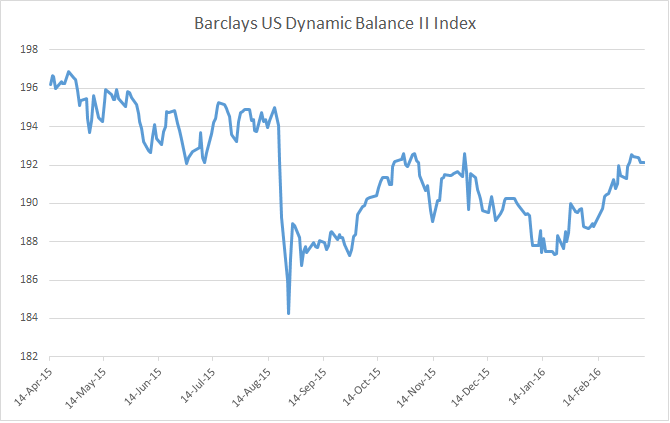
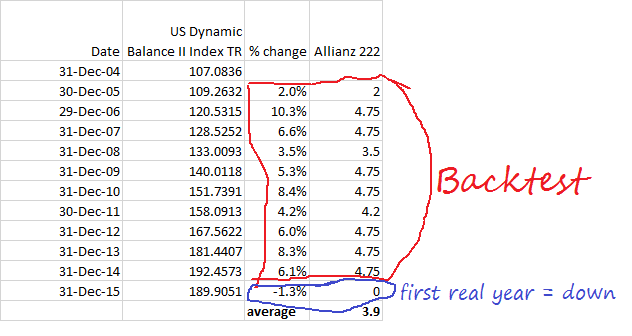
This is a brand new index that you shouldn't count on reproducing the back tested results because the live results are pretty ugly so far. For those that chose this option in its first year of existence will probably be disappointed to see a big fat zero return that it will likely produce on the contract anniversary.
The back tested results should be considered the absolute best case scenario. Don't expect those results going forward.
Remember with all index choices, Allianz can change the caps and spreads on the annual reset so that makes it even more challenging to forecast returns.
===================================================================================
July 2018 update
The newest crediting option available is the BlackRock iBLD Claria Index which was designed specifically for annuities. It is essentially a balanced option which tracks a blend of 7 exchange traded funds (4 stock ETFs and 3 fixed income ETFs). Remember that you aren't actually invested in the actual ETFs but your interest will be determined by the performance of these ETFs. There is very little history as you can download pricing going back to February 14, 2018 from the Blackrock website.
You can also choose the PIMCO Tactical Balanced Index as an interest crediting option. This index was created on December 7, 2015 but they have a chart showing back-tested performance.
Neither of these options is particularly exciting and do not change the substance of my original review. My conclusion remains the same.
Through September 17, 2018, the premium bonus has increased from 22% to 30%. Read more in my latest blog post “What is the Allianz 222's extra premium bonus worth?”
====================================================================================
August 2021 rates:
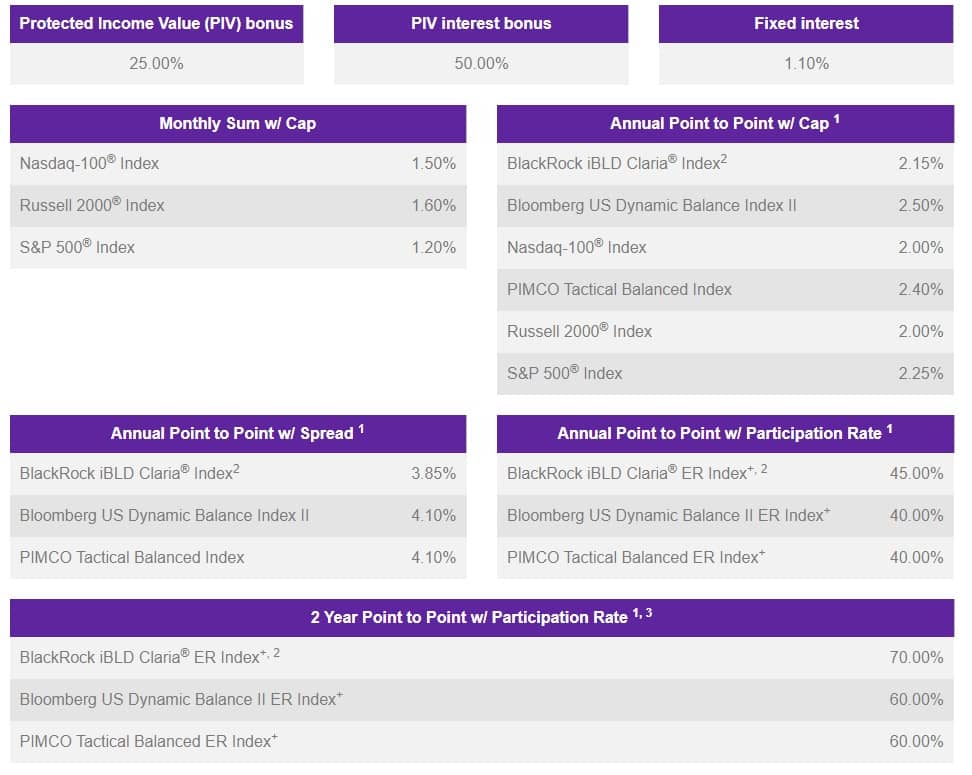
Now that more time has passed, here is some more information about the BlackRock iBLD Claria Index. It is made up of 7 ETFs (4 equity ETFs and 3 fixed income ETFs with roughly a 50/50 split). Here is a chart of the historical performance:
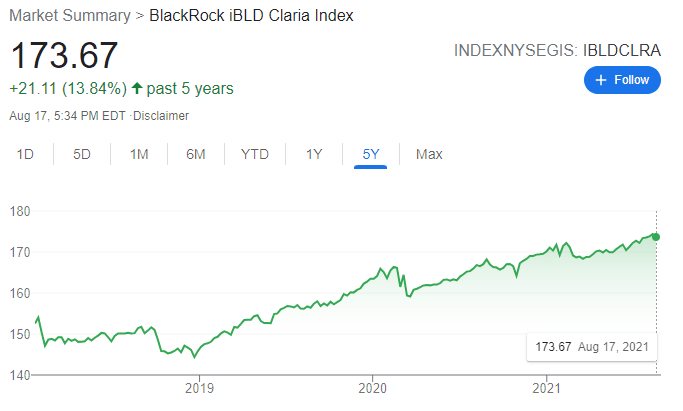
Here are the cumulative returns as of July 31, 2021:

This isn't going to blow the doors off in terms of performance and none of the indices are meant to. Here you will be lucky to see 4-5% return and remember that the annual cap is 2.15%; and if you select the participation rate option of 45%, it is roughly the same.
Back to the original review
Let's dig into this annuity so you have a better understanding of the nuts and bolts…
Interest Crediting Options
It is important to understand that you are not investing in the underlying securities of any index. With index annuities, you are not making investment choices like a variable annuity. Your interest crediting options are mathematical formulas that the insurance company is using to attract you into buying xyz annuity. The insurance company invests your money in whatever they choose (likely diversified, conservative investments). They just have to earn a return higher than their mathematical formula (or interest crediting option) so they can pay you, their sales force, marketing, operations, etc. This is why index annuities will only generate low single-digit returns.
For the Allianz 222 Annuity, you may select from 6 different interest crediting options: the Fixed interest allocation and Indexed interest allocations (S&P 500, Nasdaq 100, Russell 2000, Barclays US Dynamic Balanced Index and a blended index). To make it a bit more complex, you have three different crediting methods: monthly sum crediting, annual point-to-point crediting and monthly average crediting. So let's dig a bit deeper into your choices.
As of May 6, 2014, the Fixed interest allocation is currently paying 1.75%. This is slightly better than a 5-year Treasury Note at 1.63%.
Updates:
- As of January 2015, reduced to 1.4%
- As of February 2015, reduced to 1.2%
- As of August 2021, reduced to 1.1%
You can likely beat the fixed account on your own.
So onto the Indexed interest options. Many salespeople may sell you on high returns but none of these options will deliver much more than 2-5% returns. If someone is promising higher returns then you need to find a more honest agent. Whatever option and crediting method you choose, you will likely make around 3% over the long term. I will illustrate this for you.
Let's first look at the monthly sum crediting method which looks at the index return with a cap (as of May 6th, 2014: 2.0% for Nasdaq 100 and S&P 500 and 2.5% for Russell 2000.)
Updates:
- As of January 2015, these have all been reduced: 1.6% for Nasdaq and S&P and 2.1% for Russell 2000
- As of February 2015, caps fell again to 1.5% for the Nasdaq and S&P and 2% for Russell 2000
- As of June 2018, monthly caps are 1.5% for Nasdaq and S&P and 1.8% for the Russell 2000
- As of August 2021, monthly caps are 1.5% for the Nasdaq, 1.6% for the Russell 2000 and just 1.2% for the S&P 500.
This cap can be changed at any time and has already declined since last month. It will never be less than 0.5%. There is no cap on negative months. For example, if the S&P went up 6% in January, you'd be credited with 1.7%. However if the S&P went down 7%, you'd be credited with -7% for that month. At the end of the year, the totals are added up and that is your return for the year. If it is negative, you don't lose anything. Here is a hypothetical example for 2012 (remember the product launched in 2013):
| Date | S&P 500 | Monthly % chg | Allianz 222 |
| Jan-12 | 1312.41 | 4.36 | 1.50 |
| Feb-12 | 1365.68 | 4.06 | 1.50 |
| Mar-12 | 1408.47 | 3.13 | 1.50 |
| Apr-12 | 1397.91 | -0.75 | -0.75 |
| May-12 | 1310.33 | -6.27 | -6.27 |
| Jun-12 | 1362.16 | 3.96 | 1.50 |
| Jul-12 | 1379.32 | 1.26 | 1.26 |
| Aug-12 | 1406.58 | 1.98 | 1.50 |
| Sep-12 | 1440.67 | 2.42 | 1.50 |
| Oct-12 | 1412.16 | -1.98 | -1.98 |
| Nov-12 | 1416.18 | 0.28 | 0.28 |
| Dec-12 | 1426.19 | 0.71 | 0.71 |
| 13.40 | 2.26 |
In 2012, if you actually invested in the S&P 500 by purchasing an ETF like SPY, you would have been up 16% thanks to price appreciation and dividends. The S&P 500 without dividends was up 13.4%. In the Allianz 222 Annuity, if you selected monthly sum crediting, you would be credited with a gain of 2.26%. If you selected the annual point-to-point crediting option, you would receive 2.25. It is important that note that Allianz can change your caps at any time. Last July, the S&P cap rate was 3.75% and today it is 3.5%.
Updates:
- As of Jan 2015, this has been reduced to just 2.5%
- February 2015 reduced to 2.25%!
- As of June 2018, the S&P annual cap is 3.25%
Let's take a look at how the Allianz 222 annuity would fare (at current cap rates) over the last 10 years. Note that these are hypothetical returns because the Allianz 222 annuity only launched in January 2013:
| Allianz 222 | |||
| S&P 500 ex dividend | monthly sum | point to point | |
| 2013 | 29.6 | 10.0 | 2.25 |
| 2012 | 13.4 | 2.9 | 2.25 |
| 2011 | 0.0 | 0 | 0 |
| 2010 | 12.8 | 0 | 2.25 |
| 2009 | 23.5 | 0 | 2.25 |
| 2008 | -38.5 | 0 | 0 |
| 2007 | 3.5 | 0 | 2.25 |
| 2006 | 13.6 | 8.6 | 2.25 |
| 2005 | 3.0 | 0 | 2.25 |
| 2004 | 9.0 | 4.3 | 2.25 |
| average | 2.58 | 1.80 | |
In this hypothetical example, the monthly sum method performed better than the annual point to point option on the S&P. As you can see, the monthly sum method produced a couple of big years (2006 and 2013) but was offset by many big fat zeros.
The Barclays US Dynamic Balance Index (UPDATE: this index has been replaced by the Barclays US Dynamic Balance Index II so this section is no longer relevant) is another interesting option. It theoretically has been very good over the past 5 years. Of course, that period was a great time to be in equities and not this index. If you go back 5 more years using current spreads (which can change at any time), this choice yields a return of 4%+. Here are the numbers using the current spread of 2.4%. The spread is subtracted from the yearly percent change. The maximum annual spread is 12%! Your return for any given year will never be lower than zero.
| Date |
US Dynamic Balance Index TR |
% change | Allianz 222 |
| Dec-03 | 340.2463 | ||
| Dec-04 | 357.3282 | 5.0 | 1.1 |
| Dec-05 | 361.2923 | 1.1 | 0.0 |
| Dec-06 | 401.2476 | 11.1 | 7.2 |
| Dec-07 | 417.5862 | 4.1 | 0.2 |
| Dec-08 | 410.8596 | -1.6 | 0.0 |
| Dec-09 | 451.9316 | 10.0 | 6.1 |
| Dec-10 | 493.1369 | 9.1 | 5.2 |
| Dec-11 | 513.618 | 4.2 | 0.3 |
| Dec-12 | 545.1212 | 6.1 | 2.2 |
| Dec-13 | 603.8816 | 10.8 | 6.9 |
| 5 year | 4.1 | ||
| 10 year | 2.9 |
2013 was a very compelling year for the monthly sum option as the S&P, Nasdaq and Russell would have posted over solid gains for the Allianz 222 owner! What a great marketing pitch for the product's first year in existence. However, you shouldn't expect this type of return over an extended period as 2013 was an exception, not the norm. Over time, I expect that all of the choices will yield between 1-3% annual returns. If you are satisfied with these types of returns then it is fine. I just don't want you to expect more because you will surely be disappointed.
If you have additional questions about these options, please submit a question using our secure form. We will answer your questions within 24 hours via email. No strings attached, just a little free help to point you in the right direction.
Who should buy this product?
In summary, the Allianz 222 Annuity is something to consider for someone that doesn't want to worry about market volatility, won't need access to their money for at least 10 years and is happy with low single-digit returns of 2-5% which all indexed annuities will return. The annuity can make sense for an extremely conservative investor who is looking for guaranteed income with no market risk. If you are happy with low investment returns and a guaranteed income stream, then this product may be acceptable for you. Be sure to evaluate how it fits into your entire investment strategy and how it will help you reach your financial goals.
In the end, all of the interest crediting options will pay roughly 2-5% over a full market cycle. If this gets too far out of line, Allianz will adjust the caps (to as low as 0.5%/month) and spreads (12% max) because they can't afford to pay more.
Don't buy into any sales pitch that is promising rates of return of 8-12% or more. It just isn't possible to generate 10% returns with no downside risk. If anyone promises you even 6%+ returns for this annuity, don't just walk away, run for the door and find a new advisor. For Allianz to pay 6% on this annuity, they would have to earn 9%+ on their own investment portfolio so they could pay you as well as their salespeople, marketing and overhead, not to mention to earn a profit themselves. Commissions are very lucrative for agents selling the Allianz 222 (over 7% in year one) so be sure that you make the right decision for you, not for their benefit.
Have questions about this Annuity?
If you're considering this annuity and have additional questions, feel free to reach out. You can contact us via our secure contact form. We will answer your questions within 24 hours via email. No strings attached, just a little free help to point you in the right direction.
